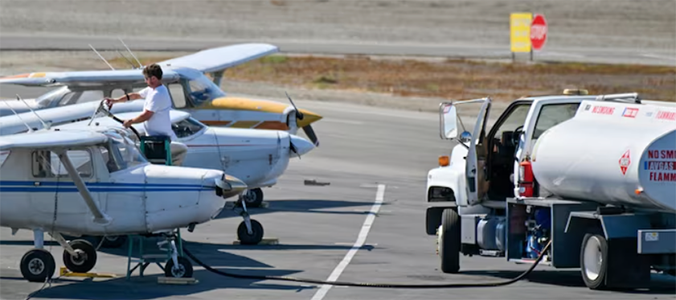Agency takes first step toward regulations aimed at reducing exposure to a dangerous neurotoxin, a potential health benefit for people who live near smaller airports
||| FROM THE WASHINGTON POST |||
The agency first proposed the move last year. It is a formal step known as an “endangerment finding,” and it now obligates the agency under the Clean Air Act to set new rules on what aircraft engines can emit.
“The science is clear: exposure to lead can cause irreversible and lifelong health effects in children,” EPA Administrator Michael Regan said in a statement. “Aircraft that use leaded fuel are the dominant source of lead emissions in our air.”
Now that the EPA has made its determination, the Federal Aviation Administration said Wednesday that it will move forward with rulemaking aimed at controlling or eliminating aviation lead emissions from piston-engine aircraft.









All the more reason for the Port of Orcas to commit to selling Unleaded fuel and getting rid of the leaded fuel. I was surprised to learn some months back that we don’t have unleaded at the Port – who knew?! Now this article makes it seem even more urgent that we switch to Unleaded as the right and decent gesture toward the people under the fallout in clustered housing – who have no choice. (and please don’t tell us to just leave the island if we don’t like sucking in pollution on a supposedly rural island!)
It seems counter-intuitive to all the work the commission has done since 2020 to keep our airport small and rural. If the Port is also going to be environmental stewards and to care for the health of people who live under those flight paths, I hope they will do the right thing – especially while the $millions are rolling in. I’ll be forwarding the link of this article to the manager and commissioners; suggest that others concerned about this contact them too. They need (and want) to hear from us.
Nice article. It’s also good timing as the port is discussing replacement of our fuels tanks. It’s an expensive endeavor and I imagine we will experience resistance from piston driven plane owners. Federal support in this direction is helpful as are the voices of our community. As a singular vote on the commission I can make no promises other than that I am in favor and will vote that way. I imagine we will be discussing this at our meeting tomorrow. We begin at 3pm to go over the budget line by line, prior to our regular business. All are welcome
This sentence doesn’t make sense: “Agency takes first step toward regulations aimed at reducing exposure to a dangerous neurotoxin, a potential health benefit for people who live near smaller airports” Benefit?
I would like to add some comments based on having followed this issue of unleaded fuel for aircraft since at least 2014. That is the year the FAA put together a group to find alternatives to the current low-lead fuel. (Note on that I am writing as a pilot and not on behalf of the Port of Orcas, for which I am one of five commissioners.)
If you would like to learn more, the best source for the history and status of non-leaded aviation fuel can be found here:
https://www.faa.gov/about/initiatives/avgas
If you dig down into all the information and links there, you will be an expert. I can’t say that I am, and I haven’t read it all, but here are some observations:
• The sky is not falling, and none of the information in the EPA paper is new. It has in fact been known for decades. The reason aviation fuel (called 100LL, with LL standing for “Low Lead”) is being discussed now is that all the large sources of lead into our environment have finally been eliminated. Piston aircraft are a very small contributor.
• That being said, they do contribute and we all want to get rid of it.
• The FAA has been on a path to eliminate it by 2030.
• You cannot just use automobile fuel on most piston aircraft. And the addition of ethanol to automobile fuel makes it even worse and even dangerous. (Dig down into the link to read the details why.)
• To be clear, there are NO viable no-lead aviation fuels currently available anywhere.
• There are two companies that have developed real alternatives to 100LL that seem to work well on piston aircraft. Some of us in the industry are frustrated that the FAA is taking as long as they are to get these fuels certified.
• It will take years, and be very expensive, to convert the supply logistics and local airport fuel systems to adapt to the new fuels once available.
• I hope Orcas can be one of the first airports to adopt the new fuels as soon as they are available. But it won’t be overnight.
Personally, I welcome the EPA paper because it will push the FAA to get this done quicker. But I hope everyone doesn’t just read scary headlines and think there is a big new problem. This problem is being solved, and there are certainly a lot of worse things to worry about if you wish to worry about things.
As Robert said this is very old news. The efforts to find an alternative to 100LL AVGas have been going on for several decades. There are now two, proven no-lead fuel formulations that eliminate the lead that older, piston engine aircraft (used to) require. One of them was approved for all piston aircraft engines in 2022. The other was approved for the low horse power engines several years ago, but not for all aircraft. Other oil companies are still attempting to develop their own formulas. So more options may become available someday as they progress through the FAA approval process. (NOTE: 100LL AVGas is NOT Jet Fuel – aviation fuel for both commercial and military jet aircraft has never had any lead in it, ever.)
Part of the problem stems from economics. AVGas is a “boutique” fuel. It’s made in very small batches. The entire world’s supply of 100L AVGas for an entire year is equal to the amount of automotive gas consumed during each weekday morning commute in the US alone. So refineries are not in a big hurry to change the formulations they currently use.
The much bigger problem now is distribution. There are no local refineries in WA that have signed contracts allowing them to produce either of the two no-lead fuels. And the cost to deliver the fuels from the 3 or 4 refineries in the US that are making the no-lead fuels is cost prohibitive.
But that will change. Regardless of the EPA’s report, Washington State already passed a law earlier this year requiring all airports in large urban areas to sell no-lead AVGas by 2026 (Seattle/Bellevue, Everett). Mid sized urban area airports must sell it by 2028 (Bellingham, Spokane, Olympia, Vancouver, Yakima). And the rest of the state (including us) by 2030. And the refineries in the state must stop making 100LL AVGas by 2030.
So yes the EPA is FINALLY getting the report done that they have been working on since the mid 1990’s done. And that will, hopefully, get the FAA to stop dragging it’s feet on approving new fuel types. But Washington already has ’em both beat.
Jack, thanks for the clarification.
Old news is still relevant. I appreciate the updates and the education.
I wonder a lot if the FAA has ever REALLY been ‘reminded’ by a huge sector of the public along with some environmental organizations? What was the upshot? My experience at watching the FAA dodge and sidewind making any changes that would lower pollution or help those living under the flight path be any safer or health
ier is… nil. I don’t know who gets the FAA to move… on anything! They seem to be above the law.
It’s good to know that Washington State is ahead of it… though that can likely be all undone with Tim Eyman’s initiatives and at the next, or some future, election.
We have been blessed with a great Orcas Port commission since 2020 – and I hope Mia will win her seat again so you all can continue. It just kills me in elections to see unopposed seats! Oh well…
I can’t help feeling that what is really needed as concerns anything FAA, is a ton of organized and persistent citizen pushback.
Thanks for explaining it all.